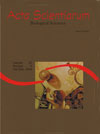<b>Effect of the age of Trichogramma exiguum and diamondback moth embryonic development on the biological characteristics of the parasitoid</b> - DOI: 10.4025/actascibiolsci.v29i2.522
Abstract
The objective of this work was to evaluate the influence of the embryonic development of eggs from the P. xylostella host on Trichogramma exiguum females of different ages. Fifty females – either just-emerged or 24, 48, 72 and 96 hours after emergence of this parasitoid were divided into five groups. Each female was offered a recipient with 30 P. xylostella eggs, which were 1-, 2- and 3-days-old. The greatest rates of parasitism were observed on eggs with 3 days of embryonic development, with exception of those 72-hours-old. Viability was not influenced by parasitoid age or host embryonic stage. Sex ratio was similar in all three embryonic host stages for T. exiguum females that were 24-, 48- and 72-hours-old. While evaluating parasitoid progeny obtained from eggs with 3, 2 and 1 days of embryonic development, it was verified that the highest values of longevity were obtained when the females used were just-emerged, or 48- and 72-hours-old, respectively. These results indicate the importance of the age of the parasitoid, as well as the host embryonic development period, in order to maintain quality of T. exiguum at laboratory conditions, in mass culture, as well as in field releases for biological pest control.Downloads
Download data is not yet available.
Published
2007-12-05
How to Cite
Polanczyk, R. A., Pratissoli, D., Holtz, A. M., Pereira, C. L. T., & Furtano, I. S. de A. (2007). <b>Effect of the age of Trichogramma exiguum and diamondback moth embryonic development on the biological characteristics of the parasitoid</b> - DOI: 10.4025/actascibiolsci.v29i2.522. Acta Scientiarum. Biological Sciences, 29(2), 161-166. https://doi.org/10.4025/actascibiolsci.v29i2.522
Issue
Section
Ecology and Limnology
DECLARATION OF ORIGINALITY AND COPYRIGHTS
I Declare that current article is original and has not been submitted for publication, in part or in whole, to any other national or international journal.
The copyrights belong exclusively to the authors. Published content is licensed under Creative Commons Attribution 4.0 (CC BY 4.0) guidelines, which allows sharing (copy and distribution of the material in any medium or format) and adaptation (remix, transform, and build upon the material) for any purpose, even commercially, under the terms of attribution.
Read this link for further information on how to use CC BY 4.0 properly.
0.6
2019CiteScore
31st percentile
Powered by 

0.6
2019CiteScore
31st percentile
Powered by 











1.png)




3.png)













